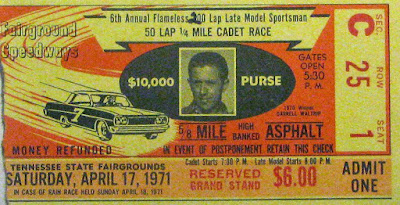Following the race, track promoter Bill Donoho floated the idea of cutting the race length to minimize the risk of another ho-hum affair. Sure enough, the lap count was cut by 100 laps, and the Flameless 200 was set for April 17, 1971.
 |
| Ticket and Nashville Banner photo courtesy of Russ Thompson |
The changes marked a transition for the track.
- More than five years had passed since the September 1965 fire that destroyed the track's grandstands.
- Gone was the original half-mile track.
- A new track now stood along with brand new, covered grandstands.
- Increased corporate dollars were beginning to flow into motorsports - both at the national level with NASCAR and R.J. Reynolds and at the local level such the Permatex support and branding at Nashville.
Perhaps the paper intentionally avoided referencing a sponsor that hadn't bought advertising in the paper - or the announcement of Permatex as the race sponsor came closer to race day - or old habits were just hard to break. One could consider the race as the final Flameless 300/200 or the first Permatex 200. Either way, it was time to race.
 |
| Source: The Tennessean |
 |
| Source: The Tennessean |
 |
| Source: Nashville Banner / Nashville Fairgrounds Racing History |
 |
| Source: The Tennessean |
 |
| Source: The Tennessean |
Waltrip, Nashville's 1970 late model sportsman division champion, returned for another full season in 1971. Gone were the traditional orange-and-white colors of owner P.B. Crowell. The #48 Chevelle instead sported a red-and-gold scheme tied to Waltrip's new sponsor and lined up alongside Ham on the front row. Coincidentally, the front row matched the two cars side-by-side in the track office's mural.
Farmer arrived in town but hardly ready to race. He suffered a broken leg on April 5th in a multi-car accident during a 100-lap race at Smoky Mountain Raceway in Maryville, TN. Farmer was a two-time, back-to-back NASCAR national late model sportsman champion in 1969 and 1970. Though early in the season, Farmer was already in a tight points battle with Georgia's Sam Sommers.
Two weeks after breaking his leg, Farmer somehow managed to belt into the car, make a pace lap, and then turn his car over to relief driver Tommy Andrews. Reason? Simple. That's what racers of that era did. Andrews did just as he was asked. He took care of Farmer's ride and managed to finish one spot ahead of Sommers. Farmer's commitment and toughness were rewarded when he won his third consecutive LMS title in 1971.
Tiny Lund was a somewhat surprising entrant. The big fella came to town with somewhat of a dual agenda (and the legendary experience of destroying his car and part of the track during the 1963 Nashville 400). He planned to race in the 200 of course. His second plan, however, was to promote the Baughman Hi Speed 100, a NASCAR Grand American division race for "pony cars" scheduled for three weeks after the 200. After qualifying mid-pack, Lund never got to tackle objective #1. He burned a clutch and didn't even start the race.
At the drop of the green, Ham took advantage of his top starting spot and led the first 48 laps. But with a good rhythm rolling, Ham suddenly lost a water pump, had to make an extended stop, and struggled to a 20th place finish. For the second consecutive year, Ham had a fast car but little to show for it.
Waltrip won the 1970 Flameless 300 in dominating fashion, but the same couldn't be said a year later. Though he qualified second and led a few laps, a blown right front tire slowed his roll. When the night was done, he finished 21st - one spot behind pole-winner Ham.
Burcham won the Flameless in 1967 and 1969. He had to like his odds of winning his third one in an odd year, but a blown engine at lap 150 pretty well ended that quest.
Local driver Flookie Buford went to the point as Burcham exited and seemed to be in control for the win. A cut tire with about 20 laps to, however, doomed his chances. He made his stop and returned to action, but he was in third and a lap down to two drivers in front of him.
As Buford limped to pit road, Chattanooga, TN's Friday Hassler took the lead. Hassler, the 1970 Flameless 300 pole winner, had to be pleased with his reversal of fortune. A year earlier, he fell out of the race after only 10 laps. In 1971's race, he found himself sitting pretty with only 20 quick laps standing between him and the trophy. But then Hassler had to have exclaimed you've GOT to be kidding me! With just six laps to go, Hassler's Chevelle broke a driveshaft. Though he had enough laps on the car behind him to not lose a position, the P3 finish was little consolation.
By process of attrition and misfortune of others, journeyman racer Art Ellis found himself out front in a lap of his own. He knocked down the handful of remaining laps and headed to victory lane. Buford finished second after his late pit stop but was still a lap down to the winner.
 |
| Source: The Tennessean |
 |
| Source: The Tennessean |
Finishing Order:
- Art Ellis
- Flookie Buford
- Friday Hassler
- Jerry Echols
- David Sisco
- Dorman Adams
- L. D. Ottinger
- Dexter Brady
- Red Farmer
- Sam Sommers
- Bob Burcham
- Rod Stillings
- Ben Pruitt
- Harold Carden
- Bill Morton
- Charley Binkley
- Bob Brown
- Robert “Paddlefoot” Wales
- Rhea Greenwell
- James Ham
- Darrell Waltrip
- Chester Albright
- Clyde Peoples
- Junior Caldwell
- Don Anthony
- Bobby Walker
- Paul Lewis
- Ronnie Blasingim
- Chuck Hunter
- Tiny Lund (DNS)
TMC






Great write up, Chase. Learned a lot.
ReplyDelete